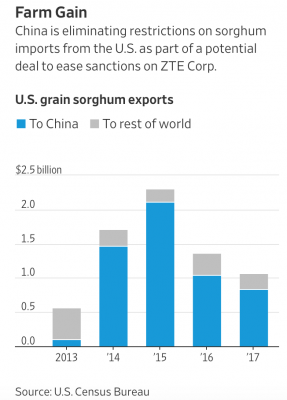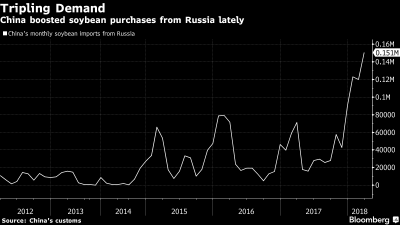As 2026 ushers in a fresh start, agricultural economists say the U.S. farm economy has stopped sliding, but it’s far from fully healed.The December Ag Economists’ Monthly Monitor shows month-to-month…
China Lifts Sorghum Tariffs, Agrees to Purchase More U.S. Goods; U.S. Suspends Tariff Implementation
Late last week China canceled its anti-dumping measure on U.S. sorghum imports. Meanwhile, after two days of trade talks in Washington, D.C., China and the U.S. issued a vague joint statement indicating that China would purchase more U.S. exports, including “meaningful increases” in agricultural and energy products. And on Sunday, Members of the President’s Cabinet provided conflicting perspectives on whether the U.S. would move forward on implementing tariffs on Chinese imports. However, news reports Monday indicated that the tariffs had been “suspended.”
China Drops Tariff on U.S. Sorghum Imports
Bloomberg News reported on Thursday that, “China scrapped an anti-dumping and anti-subsidy probe into U.S. sorghum imports as the two countries seek to resolve a trade dispute.
“The investigation isn’t in line with public interest, China’s Ministry of Commerce said in a statement on Friday. The Asian country announced the probe in February and in April imposed a 178.6 percent anti-dumping deposit. The ministry said it will return the deposits.”

The article explained that, “China imported about $957 million of U.S. sorghum in 2017 and purchases fell 15 percent in the first quarter of this year from a year earlier, according to customs data. Farmers had used the grain in animal feed in place of domestic corn, which climbed 20 percent last year. Pig prices in the world’s biggest pork consumer and producer have slumped more than 30 percent this year.”
Last week’s article added,
While the move will please U.S. sorghum farmers, China’s soy buyers remain cautious, said Paul Burke, North Asia regional director for the U.S. Soybean Export Council. ‘I do not think importers will begin buying soybeans until there is a clear statement from the Chinese government that they will not impose a 25 percent duty,’ he said in an email.
The Financial Times reported on Friday that, “The [Chinese sorghum] announcement came just hours after US President Donald Trump received Liu He, China’s lead trade negotiator and vice-premier, in the Oval Office on Thursday.”
Looks like some progress is being made in China US trade negotiations China will take sorghum again Chyna will return deposits they’ve required on our agricultural exports little bit of light at the end of the tunnel on Chinese US trade fight
— ChuckGrassley (@ChuckGrassley) May 19, 2018
With respect to Chinese soybean purchases, Bloomberg writer Anatoly Medetsky reported Thursday that, “China, the world’s biggest soybean importer, almost tripled purchases from Russia amid a trade dispute with the U.S., the biggest producer.
“Russia sold about 850,000 metric tons of soybeans to China from the start of the 12-month season in July through mid-May, according to Russia’s agriculture agency Rosselkhoznadzor. That’s more than during any season before and compares with about 340,000 tons sold during all of the previous period, Chinese customs data show.”

The article noted that, “China has already canceled several shipments from the U.S. in anticipation of tariffs on the country’s products. While Brazil is expected to take much of that market share, Russia is also benefiting.”
And Reuters writer Carl Plume reported late last week that, “Orders for nearly 1 million tonnes of U.S. soybean exports were canceled this week, according to U.S. government data released on Friday, as cheap supplies from Brazil and trade tension with China made U.S. cargoes less attractive to buyers.
“The U.S. Department of Agriculture did not detail which buyers canceled the cargoes in a daily announcement of large export deals. But China buys the lion’s share of U.S. soybean exports and trade sources said most of the shipments were likely headed there.”
U.S. China Talks End With Vague Pledge
Financial Times writers Shawn Donnan and Tom Mitchell reported on Saturday that, “Chinese officials have indicated their willingness to buy more US exports but stopped short of accepting US President Donald Trump’s demand for a $200bn reduction in their bilateral trade surplus, as the two sides failed to agree on relief measures for a Chinese telecommunications company hit by crippling US sanctions.
“In a joint statement released on Saturday the two sides said they had agreed on the need for ‘effective measures to substantially reduce’ the US $337bn annual trade deficit with China.
“They said that after two days of ‘constructive talks’ China had agreed to ‘significantly increase’ its purchases of US goods and services and on the need for ‘meaningful increases’ in US agricultural and energy exports to China.”
China has agreed to buy massive amounts of ADDITIONAL Farm/Agricultural Products - would be one of the best things to happen to our farmers in many years!
— Donald J. Trump (@realDonaldTrump) May 21, 2018
Under our potential deal with China, they will purchase from our Great American Farmers practically as much as our Farmers can produce.
— Donald J. Trump (@realDonaldTrump) May 21, 2018
USDA Undersecretary for Trade Ted McKinney, in China, said he doesn't want to people to get overly excited. He said we should be "very cautiously optimistic" (he repeated multiple times). "I do like the tweet, though." https://t.co/iMFqo1NpDf
— Chris Clayton (@ChrisClaytonDTN) May 21, 2018
On Monday, Evelyn Chang reported at CNBC Online reported that, “American beef, corn and soybeans could benefit the most from the latest trade agreements between the U.S. and China.”
“‘We estimate a potential increase of US$60-90bn in Chinese purchases of US goods, with a rise in agriculture imports (particularly beef) in the near term,’ Morgan Stanley Economist Robin Xing, Strategist Michael Zezas and their team said in a note Sunday.”
After Uncertainty, Tariffs “Suspended”
Wall Street Journal writers Bob Davis and Josh Zumbrun reported Sunday that, “The Treasury secretary and the administration’s top trade official took markedly different positions over whether the U.S. will move forward with tariffs on Chinese imports, punctuating several days of negotiations between the world’s two biggest economies with a question mark.
“Several hours after Treasury Secretary Steven Mnuchin told Fox News on Sunday that the U.S. was ‘putting the trade war on hold’ [see clip below] and wouldn’t assess tariffs on Beijing while the two sides talked, U.S. Trade Representative Robert Lighthizer put out a statement saying that tariffs remained an important tool to ‘protect our technology.'”
In an exclusive interview, @stevenmnuchin1 tells Chris: "We're putting the trade war on hold, so right now we have agreed to put the tariffs on hold while we try to execute the framework." pic.twitter.com/fJXKozKxK5
— FoxNewsSunday (@FoxNewsSunday) May 20, 2018
“Mr. Lighthizer didn’t say the U.S. would resort to tariffs any time soon, and Mr. Mnuchin didn’t rule out tariffs, and a U.S. trade official played down the disparity, but trade experts said the differences in tone and substance stood out. People familiar with the administration’s internal deliberations said Mr. Lighthizer was signaling that he wouldn’t accept a watered-down version of U.S. goals or tactics in the trade dispute with China.”
The Journal article stated, “C. Donald Johnson, a former USTR negotiator and trade lawyer in the Clinton administration, said conflicting statements from Washington’s negotiators don’t help U.S. negotiations.”
Financial Times writer Shawn Donnan reported on Sunday that, “Wilbur Ross, the US commerce secretary, would be travelling to China in the weeks to come to negotiate details of Chinese purchases, Mr Mnuchin said. But he said the US side had very specific ‘industry by industry’ targets in mind, raising the possibility of a 35-40 per cent increase in agricultural imports this year and an additional $50bn-$60bn in annual US energy exports over the next three to five years.”
On China, Barriers and Tariffs to come down for first time.
— Donald J. Trump (@realDonaldTrump) May 21, 2018
And Bloomberg writers Andrew Mayeda and Mark Niquette reported on Sunday that, “Mnuchin’s remarks will be a relief to investors, who had feared the world’s two biggest economies were on the brink of an all-out trade conflict. The International Monetary Fund has warned that a global trade war would undermine the broadest global upswing in years.
“Still, when asked on CBS’s ‘Face the Nation’ Sunday whether Trump has taken the threat of tariffs off the table, Larry Kudlow, Trump’s top economic adviser, said, ‘I don’t think we’re at that stage yet.'” (see clip below).
"Are we going to get everything? I don't know. But I will say this, we're making terrific progress."
— Face The Nation (@FaceTheNation) May 20, 2018
➡️ @larry_kudlow discussed trade talks with #China https://t.co/nr8A5N9IWw pic.twitter.com/8LZCmQzGNj
The Bloomberg article added, “The Chinese are offering to make structural reforms such as lowering tariffs and other import barriers that will allow the U.S. to export ‘billions and billions’ of additional goods to China, Kudlow said on ABC.”
NEC Dir. Larry Kudlow tells @gstephanopoulos following trade talks with China: "There's no agreement for a deal, we never anticipated one, there's a communique between the two great countries. That's all." #ThisWeek pic.twitter.com/oj6goENJFA
— This Week (@ThisWeekABC) May 20, 2018
“‘We made a lot of progress here in Washington and built on what happened in China,’ Kudlow said. ‘The president is in a very positive mood about this. I myself am very encouraged,'” the Bloomberg article said.
And on Monday, Josh Zumbrun reported at The Wall Street Journal Online that, “The U.S. suspended its threat to impose tariffs on $150 billion in Chinese imports to the U.S. while negotiations with China continue, but President Donald Trump could impose the tariffs if a deal between the two countries doesn’t progress, Treasury Secretary Steven Mnuchin said.
“‘Both parties have agreed to suspend the tariffs,’ Mr. Mnuchin said Monday in an interview on CNBC, echoing remarks he gave over the weekend. He specified that the U.S. was pausing its efforts to apply tariffs to $150 billion in Chinese imports to the U.S., and that China would hold its threat to retaliate with tariffs on $50 billion in U.S. goods.
“If the negotiations aren’t successful, however, ‘the president can always put tariffs back on,’ he said.”
The Journal article noted, “‘Tariffs are suspended right now, that’s a good thing,’ Mr. Kudlow said, also speaking on CNBC. ‘But you cannot remove tariffs as a negotiating tool or an enforcement tool from this process.’
.@larry_kudlow on China: "They're going to reduce tariffs and non-tariff barriers for private sector transactions." pic.twitter.com/XfpdgyaE6i
— FOX Business (@FoxBusiness) May 21, 2018
“Their remarks came a day after Mr. Mnuchin and U.S. Trade Representative Robert Lighthizer both made statements that had left the exact position of the U.S. unclear.”
Emiko Terazono reported on Monday at The Financial Times Online that, “Grains and soyabeans rallied on the US-China trade war truce, with corn hitting a near two-year high.
“The joint statement from the US and China on Saturday in which Beijing pledged to ‘significantly increase’ imports of American farm exports and energy buoyed sentiment, while Friday’s announcement that China was removing the anti-dumping duty on US sorghum also opened doors to the idea of a better trade relationship with the worlds largest buyer, said Matt Ammermann at commodity brokers INTL FCStone.”





